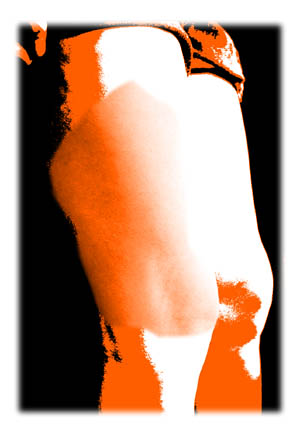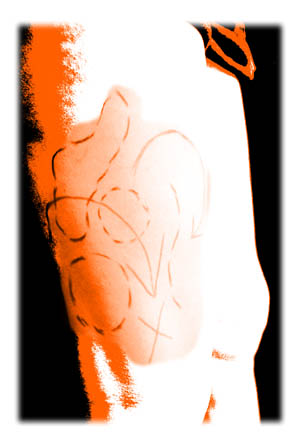
|
Article
|
|
Artist of the Flesh |
jason orlovich buzz fine arts writer
ellen steele buzz photographer |
|
|
|
Even the magazines line up. Tables rise at a perfect 90-degree angle from the floor. The carpet has gray
boxes every three feet. Even the sunlight carves into a semblance of
order as it enters the square windows. And the iron beams are perfectly
in line with space the ceiling creates.
The room’s symmetry is unbearable. The building’s symmetry is nothing short of genius—if not meticulously planned out.
Waiting
for Dr. Robert Klausner in a warm room in Carle Clinic’s Center for
Cosmetic Surgery, 1702 S. Mattis Ave, Champaign, one cannot help but
wonder about the appearance of things. Even more immediate subjects in
the room deserve judgement. Like, what part of her body does that woman
hate? Do the nurses get an employee discount? Will Business Weekly and
ESPN Magazine (as opposed to GQ or Vanity Fair) satisfy Klausner’s
average customer?
A woman wearing what looks like a hair net peers out from behind the check-in window and speaks for the invisible doctor.
“He’ll be finished in about 45 minutes.”
Over
the phone a day earlier, Klausner describes an especially “intense”
five-hour procedure in which he performed a complete cosmetic overhaul.
His yawns that night were well deserved, considering five hours was
less than typical for the three-and-a-half days of scheduled operations
during a normal week. Today would be a “lighter surgery day.” But that
included, among other procedures steeped in medical jargon, “putting a
kid’s ear back together.”
When asked what every doctor has
been asked at least once in their career—”What made you want to do what
you’re doing?”—Klausner answers sincerely and without hesitation. He
notes a predisposition to high dexterity and an interest in art and
aesthetics as a child—two seemingly incongruous motivations in the very
technical field of medicine.
Yet, as Klausner’s
commanding, conversational tone takes over, such claims fall into place
without question. Expected answers involving dead pets, large trucks
and adolescence now seem all too soft. |
 |
 |
“I’ve
always been someone who’s enjoyed doing things with my hands,” he says.
“Facial and plastic surgery is the most challenging [specialization]
there is; it’s one that has to reach the highest standard.” Indeed,
Klausner’s career revolves around daily challenges outside of simple
medical cures—unlike other medical fields, the quality of a plastic
surgeon’s work is almost solely judged by the patient.
“The
[plastic surgery] patient is unique,” Klausner says. “He or she is a
shopper.” Klausner noted plastic surgery is a “very, very competitive
field.”
“[Patients] make [doctors] competitive with each
other,” he says. “They shop on the Net, talk to people; they’re
regular, well-educated folks who are interested in looking better and
feeling better about themselves.”
Such phrases might read like an infomercial, but Klausner’s reasons are legitimate.
“They
all want to look in the mirror ... want to look as good as they feel,”
he says. “You see yourself as a certain way and you don’t see what’s
reflected in the mind’s eye.”
Klausner says the most rewarding
experience as a doctor is seeing a patient’s self-confidence change
after an operation. Still, his decision to become a plastic surgeon was
not made without experiencing other fields during his rotations in
medical school.
“I like the operating room and I like the
challenge,” he says, returning to the original question. “I wanted a
combination of an office practice with a surgical practice.”
At
38, Klausner considers himself young for his profession, but the years
of medical training at the University of Pennsylvania might cause
anyone to age more quickly than expected.
Here is
Klausner’s history printed in the manner it was recited: Four years at
the University of Pennsylvania; four years of medical school
(Pennsylvania); one year of internships in general surgery; four years
of surgery specializing in the head and neck; a one-year fellowship and
five years of practice beginning in 1995 in Danville, Ill.
Miscellaneous information Klausner tossed in included being born and
raised in Indianapolis, Indiana and attending a Jesuit high
school.
While every case is unique in terms of a patient’s
motivation for seeing a plastic surgeon, Klausner says he begins every
meeting the same way. Following an introduction, he asks one question:
“What brings you to see me today?”
“Then I let them start
talking,” he says. Klausner says above all, he tries to “focus the
patient” to help them figure out what they want.
“I try to
get them to prioritize,” he says. “Then I ask, ‘If there’s one thing I
can fix for you today, what would it be?’” Klausner says he is
especially weary of patients who do not know what they want after an
initial meeting. He said that is always a “red flag” situation.
|
|
Similarly,
Klausner will refuse to do surgery that cannot be done. He notes cases
where a man who looks like Danny DeVito will walk in with a picture of
Brad Pitt and say, “Make me look like this.”
“You need to present
realistic things,” he says. “I always tell [my patients] that the sign
on the wall says ‘physician’ not ‘magician.’” Other common grounds for
the doctor’s refusal might include a patient’s current state of
health.
“I’m like a pilot,” he says. “I have to say if
things are safe to proceed.” Klausner cites the risk of a recent
heart-attack victim withstanding anesthesia six months after an
operation. “Then I tell them to call up their doctor,” he says.
It
would seem a large part of Klausner’s job before any surgery is done to
make such goals or complications clear to the patient.
“I give
them a lot of information on the first visit,” he says, referring to
the catalogue of videos and literature in his office. “And a lot of
people [will go home] and want to digest that.” Klausner says he uses a
computer morphing program to show patients before and after photos of
what could be done.
“That’s my job to get them [on the
same page] before surgery,” he says. “It’s like any other service that
you’re going to sell to people.”
Indeed, such intense preparation
is to be expected when what is being sold can range between “a few
hundred to $10,000.” While the doctor states, rather plainly, “the
price is the price,” he said there is “not a day that goes by when
people don’t try to barter” for his services. Regardless, the results
might not always meet the expectations.
“There are so many
reasons why people are dissatisfied,” he says. “You try to handle them
the best you can, but the commonly dissatisfied patient is the
impatient patient.”
“Those who really want a quick fix get
frustrated,” he says. It might take a few months to a year before the
swelling is gone after an operation, he says.
Klausner’s solution to solving this very realistic problem is to see his patients frequently after surgery.
“It’s
quality control for me so I can see how my results are holding up,” he
says. Klausner usually schedules checkups on the day after the
operation, then after two weeks, one month, three months, six months
and one year—”I enjoy doing that.”
Still, the need for an occasional touch-up is always a possibility.
“Sometimes
we do a little spot welding down the line,” he says, comparing his job
to painting or woodworking. “You really reserve the right to do that.”
Yet Klausner says because his standards are normally higher than his
patients’, additional surgery is rare.
“It’s usually me who
offers,” he says, adding that is the case with most good doctors. “I
tend to be more critical of my results than my patients are.”
|
 |
|
A more interesting situation sometimes occurs when a patient will ask Klausner to “correct” the work of another doctor.
“That’s definitely more challenging,” he says. One is instantly reminded of Klausner’s motivations for choosing the field.
“The
patient is already dissatisfied with a plastic surgeon,” he says.
“They’re skeptical and naturally so.” Klausner says trying to put those
patients at ease is more difficult than with first-time patients.
Yet
perhaps the most interesting point of Klausner’s inside knowledge comes
at the end of the conversation when he mentions cosmetic surgery’s
stigma and its gradual shift over the past 20 years from being a
“Beverly Hills phenomenon” to becoming “more and more accepted.”
“In some circles, it has become a badge of honor,” he says plainly. “It becomes a status symbol.”
On
one hand, it is good to know a man of Klausner’s power will not turn
every Danny DeVito of the world into a Brad Pitt. Yet if such
transformations are becoming more socially acceptable, one might begin
to wonder about things other than a waiting room’s symmetry.
Klausner offers a simple comparison: “It’s really no different than braces, right?”
The doctor makes his point clear.
|
| |
| |
 |
Any information
provided on this Web site should not be considered medical advice or a
substitute for a consultation with a physician. If you have a medical
problem, contact your local physician for diagnosis and treatment.
Proudly Serving Naples Florida, Bonita Springs Florida, Fort Myers Florida and surrounding areas.
|
|





